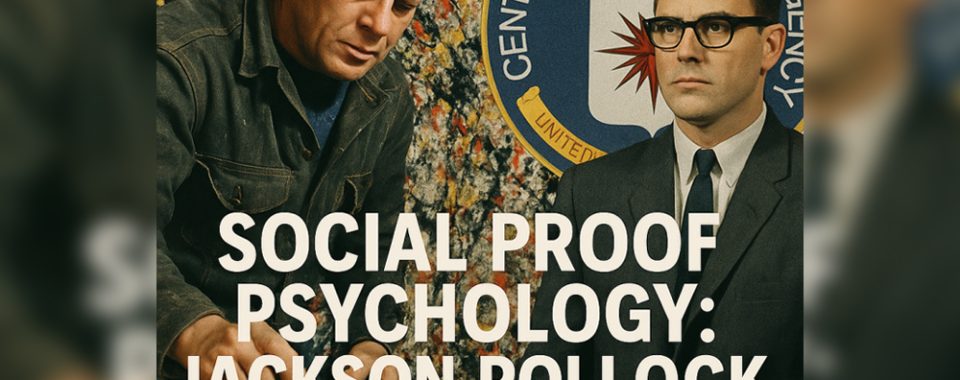
The Psychology of Social Proof: Lessons from Jackson Pollock and the CIA
Social proof, a powerful psychological phenomenon where people mimic the actions and beliefs of others, significantly shapes human behavior. Rooted deeply in our need for social validation and acceptance, this principle is leveraged in marketing, politics, culture, and more. Understanding the psychological underpinnings of social proof can offer invaluable insights into influencing perceptions and driving behavior.
One compelling historical example illustrating social proof’s potency involves abstract expressionist painter Jackson Pollock and the covert involvement of the Central Intelligence Agency (CIA).
Jackson Pollock: Challenging Perceptions with Abstract Expressionism
In the mid-20th century, Jackson Pollock introduced his revolutionary drip painting technique, dramatically challenging conventional artistic norms. Initially, his abstract style encountered significant skepticism and controversy, reflective of human psychological resistance to unfamiliar stimuli and the innate preference for familiarity and clarity.
Pollock’s eventual rise to fame hinged significantly on the psychological mechanism of social proof. Influential critics and prestigious institutions began endorsing his work, effectively transforming public perception. Psychologically, such endorsements served as authoritative cues, alleviating uncertainty and providing validation, thus reshaping public attitudes and tastes towards Pollock’s previously misunderstood art.
The CIA and the Strategic Use of Social Proof
Remarkably, one influential supporter of Pollock’s work was the CIA, who strategically harnessed social proof during the Cold War. Understanding the psychological impact of cultural influence, the CIA covertly promoted Pollock and other abstract expressionists to symbolize American creative freedom, starkly contrasted against restrictive Soviet artistic norms.
Through subtle funding of exhibitions, media coverage, and international art showcases, the CIA intentionally created powerful social proof. By associating abstract expressionism with democratic freedom and intellectual superiority, they leveraged psychological principles such as authority bias and conformity to elevate Pollock’s art and, by extension, American cultural prestige.
The Psychological Dynamics Behind Social Proof
The success of the CIA’s efforts underscores core psychological concepts. Humans are innately social creatures who often seek guidance from others to navigate ambiguity. Endorsements from authoritative or trusted figures effectively reduce uncertainty, signaling to individuals what is valuable or desirable.
Common psychological dynamics of social proof include:
- Authority Bias: Tendency to trust and emulate authorities.
- Conformity: Adapting behaviors or beliefs to align with group norms.
- Bandwagon Effect: Growing acceptance driven by increasing popularity.
Applying Psychological Insights into Social Proof
To effectively utilize social proof, consider these psychologically-backed strategies:
- Authority Endorsements: Leverage testimonials or approvals from recognized experts to establish credibility.
- User-Generated Content: Display real customer reviews prominently, harnessing the power of peer influence.
- Certifications and Awards: Emphasize recognition from reputable bodies to bolster perceived reliability and trustworthiness.
- Influencer Partnerships: Collaborate strategically with trusted influencers who resonate deeply with target audiences.
Concluding Insights: Pollock’s Psychological Legacy
Jackson Pollock’s transition from a controversial figure to an iconic artist vividly demonstrates how psychological principles underpin social proof’s power. Whether influenced genuinely or manipulated strategically—as exemplified by the CIA—social proof dramatically shapes societal attitudes and behaviors.
By deeply understanding and strategically applying these psychological insights, individuals, brands, and businesses can more effectively shape perceptions, build trust, and foster significant influence in their fields.








